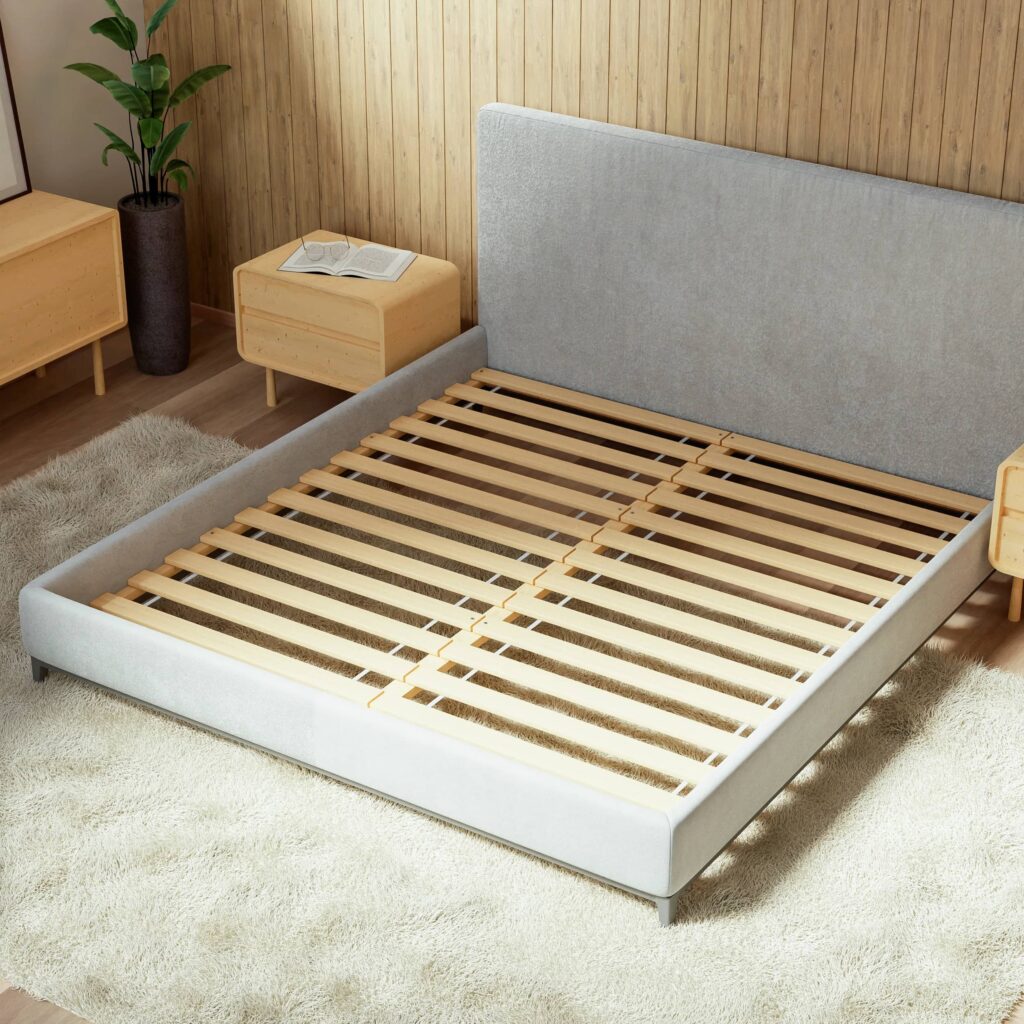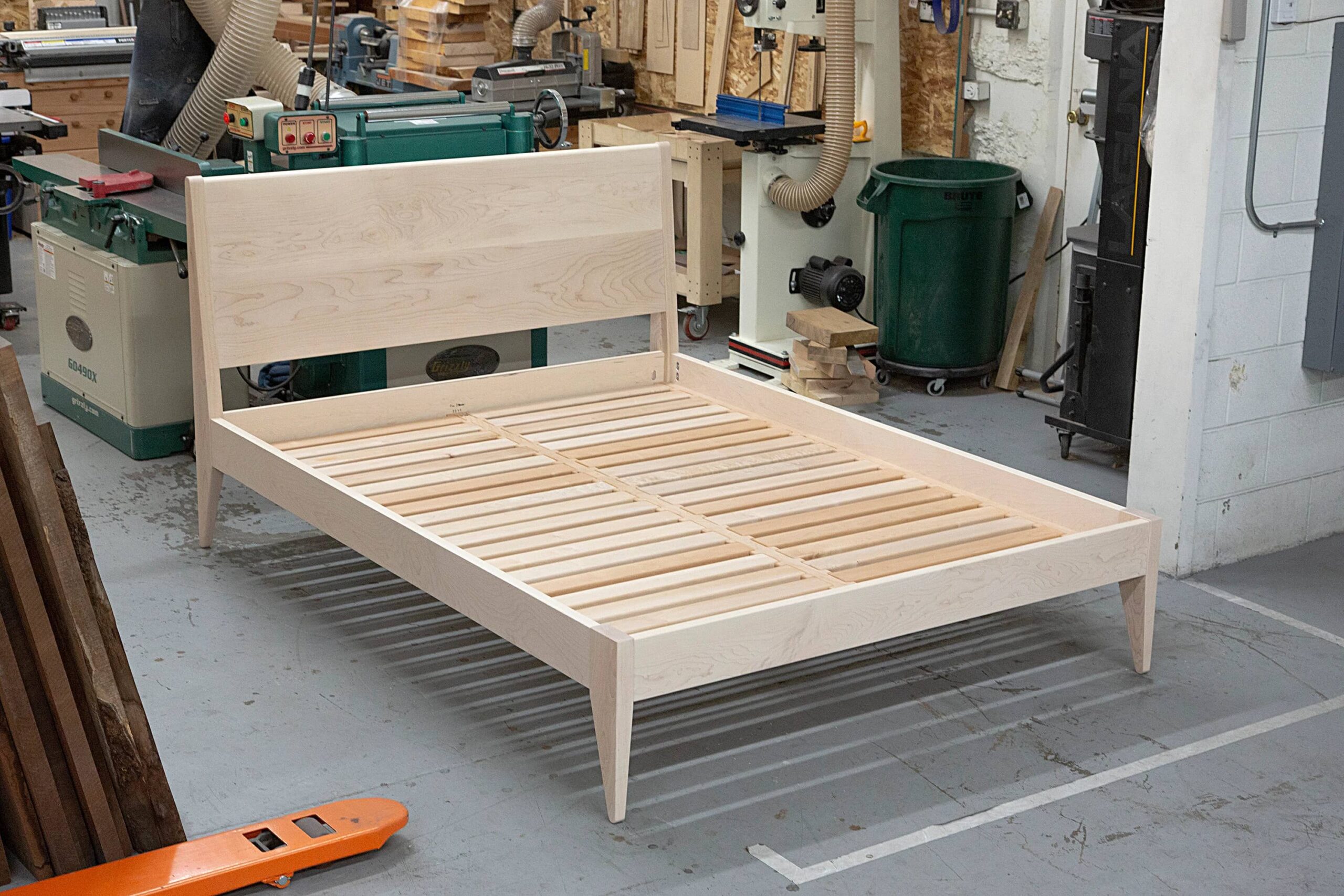We’ve all been there – waking up with a crick in our neck, wondering if we spent the night battling our mattress instead of drifting off to dreamland. While a high-quality mattress is undeniably essential for a good night’s sleep, the often-unsung heroes of slumber are the bed slats. These humble supports play a pivotal role in preventing that dreaded mattress sag and ensuring your customers wake up feeling refreshed and ready to conquer the day.
But here’s the million-dollar question: how far apart should bed slats be to create the perfect harmony between mattress and frame? This comprehensive guide delves into the intricacies of bed slat spacing, equipping you with the knowledge and insights needed to guide your customers toward their best sleep ever.

Why Slat Spacing Matters: It’s the Secret to a Supportive and Hygienic Sleep Haven
Before we jump into the nitty-gritty of spacing, let’s understand why it’s such a critical factor in bed design and customer satisfaction. Think of it as the difference between a house built on solid ground versus one teetering on stilts – the foundation matters!
- The Unsung Heroes of Support: Bed slats are the unsung heroes of mattress support, acting as a foundation that distributes weight evenly across the entire surface. Proper spacing ensures the mattress doesn’t sag or dip, promoting proper spinal alignment and a more comfortable sleep experience. This is especially crucial for individuals with back problems or those who tend to sleep on their sides, as it helps maintain the natural curvature of the spine. A well-supported spine translates to less pain, reduced pressure points, and a more restful sleep overall.
- Breathability for a Fresher, Healthier Sleep: Adequate spacing between slats allows for optimal airflow beneath the mattress. This ventilation is not just about a breath of fresh air; it’s about creating a healthier sleep environment. Good airflow helps dissipate heat and moisture, which are breeding grounds for mold, mildew, and those unpleasant musty odors nobody wants to wake up to. A mattress that can breathe is a mattress that stays fresher longer, contributing to a healthier sleep environment for your customers and potentially reducing allergy symptoms for those sensitive to dust mites.
- Extending Mattress Lifespan for a Wise Investment: A well-supported mattress is a longer-lasting mattress. Proper slat spacing prevents excessive stress and strain on the mattress, ultimately extending its lifespan and maximizing your customers’ investment. When a mattress is adequately supported, it’s less likely to develop premature sagging, indentations, or structural damage, saving your customers money in the long run and reducing the need for frequent mattress replacements.
Decoding the Spacing Code: Finding the Sweet Spot for Every Mattress Type
Just like finding the perfect pillow, the ideal bed slat spacing isn’t a one-size-fits-all scenario; it depends largely on the type of mattress your customers choose. Here’s a breakdown of recommended spacing for different mattress types, ensuring optimal support and comfort for every sleeper:
1. Memory Foam Mattresses: Closer Support for Contouring Comfort
Memory foam mattresses are renowned for their body-conforming comfort and pressure-relieving properties, making them a popular choice for individuals seeking a luxurious sleep experience. However, their dense structure requires more support from the bed frame to prevent that sinking feeling.
- Recommended Spacing: For memory foam mattresses, aim for a slat spacing of 2-3 inches (5-7.5 cm). This closer spacing provides the necessary foundation to prevent the mattress from sinking between the slats and compromising its contouring abilities. This is crucial for maximizing the pressure-relieving benefits of memory foam and ensuring a comfortable, supportive sleep. Too much space between slats can lead to the mattress conforming unevenly, creating uncomfortable pressure points and reducing the overall effectiveness of the memory foam.
2. Latex Mattresses: Striking a Balance Between Support and Breathability
Latex mattresses, crafted from natural rubber, are celebrated for their natural resilience, breathability, and hypoallergenic properties, making them a favorite among eco-conscious consumers and those with allergies.
- Recommended Spacing: A slat spacing of 2.5-3.5 inches (6-9 cm) is generally ideal for latex mattresses. This range offers a harmonious balance of support and ventilation, allowing the mattress to breathe while preventing excessive sagging. This spacing also helps maintain the natural springiness of latex, enhancing its comfort and longevity. Wider spacing might not provide enough support for the latex to bounce back effectively, leading to premature sagging.
3. Innerspring Mattresses: A Bit More Breathing Room for Classic Comfort
Innerspring mattresses, the traditional workhorses of the mattress world, rely on a system of interconnected coils to provide support. They are generally more forgiving when it comes to slat spacing due to their inherent springiness.
- Recommended Spacing: For innerspring mattresses, a spacing of 3-4 inches (7.5-10 cm) is typically sufficient to provide adequate support and ventilation. However, it’s always wise to consult the mattress manufacturer’s recommendations, as some innerspring mattresses with thicker coils or additional comfort layers, like pillow tops, might benefit from slightly closer spacing to prevent sagging and maximize their lifespan. Spacing that’s too close, however, can restrict airflow and might even void certain mattress warranties, so it’s essential to find the sweet spot.
Beyond Mattress Type: Other Factors That Play a Part in Slat Spacing
While mattress type is a primary consideration, other factors can influence the ideal slat spacing for a truly customized sleep setup:
- Slat Thickness and Width: The Building Blocks of Support: Just like a sturdy house needs strong beams, thicker, wider slats generally offer greater support and can handle wider spacing without compromising mattress integrity. Conversely, thinner slats might require closer spacing to provide adequate support and prevent the mattress from sagging between them. The material of the slats also plays a role – hardwood slats tend to be stronger and more durable than softwood slats, allowing for slightly wider spacing.
- Weight Distribution: Ensuring Even Support for All Sleepers: If the bed will be shared by individuals with significantly different weights, closer slat spacing can help ensure even weight distribution and prevent the mattress from sagging unevenly. This is particularly important for couples with a significant weight difference, as it helps create a more balanced and comfortable sleep surface for both individuals. Consider recommending a center support rail for larger beds shared by individuals with significant weight differences to further enhance support and prevent sagging.
- Personal Preference: Because Comfort is Subjective: Ultimately, comfort is a deeply personal experience. While these guidelines provide a solid starting point, some individuals might prefer slightly closer or wider slat spacing based on their unique preferences and sleep habits. Encourage your customers to experiment and find what feels best for them. Providing adjustable bed frames with customizable slat spacing can be a great way to cater to individual preferences and ensure optimal comfort for every customer.
Visualizing the Impact: Slat Spacing in Action
Let’s bring this information to life with a simple table that illustrates the importance of proper slat spacing:
| Mattress Type | Ideal Slat Spacing | Too Wide Spacing | Too Close Spacing |
|---|---|---|---|
| Memory Foam | 2-3 inches | Sagging, poor support, reduced mattress lifespan, diminished pressure relief | Reduced airflow, potential for mold and mildew, stiffness |
| Latex | 2.5-3.5 inches | Slight sagging, potential for uneven support, reduced breathability | Slightly reduced airflow, potential for stiffness |
| Innerspring | 3-4 inches | Minimal impact on support, adequate airflow | Unnecessary, may void mattress warranty, potential for reduced airflow |
Going the Extra Mile: Tips for Optimal Bed Slat Support and Customer Satisfaction
- Center Support Rail: The Backbone of Larger Beds: For larger beds, such as Queen, King, and California King sizes, consider recommending a center support rail. This additional support beam runs down the middle of the bed frame, providing extra support where the mattress experiences the most weight. It prevents sagging and ensures even weight distribution, especially crucial for larger mattresses that tend to sag more easily over time. A center support rail is a relatively inexpensive addition that can significantly enhance the lifespan and comfort of a mattress, making it a valuable selling point for your customers.
- Slat Support Caps: Small Details, Big Impact: These often-overlooked accessories are small caps that sit on top of the bed frame, preventing the slats from shifting or moving out of place. They might seem insignificant, but they play a crucial role in maintaining consistent slat spacing, preventing annoying squeaking noises, and ensuring long-term mattress support. Slat support caps are an easy and affordable way to prevent unnecessary wear and tear on both the slats and the mattress, contributing to a quieter and more restful sleep experience.
- Regular Inspection: A Stitch in Time Saves Nine: Bed slats, like any part of a bed frame, can weaken, warp, or break over time due to wear and tear. Encourage your customers to inspect their bed slats periodically and replace any damaged or worn-out slats promptly to maintain optimal mattress support and prevent premature mattress sagging. This simple maintenance tip can save your customers money in the long run by extending the lifespan of their mattress and ensuring a consistently comfortable sleep surface.
Slat Spacing and Warranty Considerations: Protecting Your Customers’ Investments
Many mattress manufacturers have specific guidelines regarding bed slat spacing to ensure optimal mattress performance and longevity. Using a bed frame with improper slat spacing can void the mattress warranty, leaving your customers responsible for costly replacements.
- Educate Your Customers: Provide clear and concise information about slat spacing requirements for different mattress types. This could be in the form of brochures, website content, or even in-store signage.
- Offer Compatible Bed Frames: Consider selling bed frames specifically designed to meet the slat spacing requirements of the mattresses you offer. This simplifies the decision-making process for your customers and ensures their mattress warranty remains valid.
- Highlight Warranty Information: When discussing bed frame options with your customers, clearly communicate the importance of slat spacing in relation to mattress warranties. This transparency builds trust and helps your customers make informed decisions that protect their investments.
FAQs: Your Bed Slat Spacing Questions, Answered!
1. Can I use my old bed frame with a new mattress, even if the bed slat spacing seems different?
While it’s tempting to save money by reusing an old bed frame, especially when upgrading to a brand new mattress, it’s crucial to ensure the bed slat spacing is compatible with your new mattress type. Remember, mattress technology and construction have evolved over time, and what worked for your old mattress might not provide adequate support for a new one. Using a bed frame with improper bed slat spacing can lead to mattress sagging, reduced comfort, and even void your mattress warranty, potentially costing you more in the long run. If you’re unsure about compatibility, consult the mattress manufacturer’s recommendations or consider investing in a new bed frame that meets the specific needs of your new mattress.
2. My bed slats are squeaking! Is it the spacing, or is something else wrong?
Squeaking bed slats are a common annoyance that can disrupt sleep and signal underlying issues with your bed frame. While improper bed slat spacing can contribute to this issue by causing bed slats to rub against the frame or each other, it’s not always the primary culprit. Before you assume it’s a spacing problem, check if the bed slats are securely attached to the bed frame and if any bed slat support caps are missing or damaged. These caps play a crucial role in minimizing friction and noise. Tightening loose screws or replacing worn-out components can often resolve the squeaking problem and restore peace to your sleep sanctuary.
3. My partner and I have very different weights. Will this affect our bed slat spacing needs?
Absolutely! When individuals with significant weight differences share a bed, closer bed slat spacing is recommended to ensure even weight distribution and prevent the mattress from sagging unevenly. This is especially important for larger mattress sizes like Queen, King, and California King, which tend to have a larger unsupported surface area. Consider a bed frame with a center support rail for added support and stability, creating a more balanced and comfortable sleep surface for both individuals, regardless of their weight difference.
4. Can I add more bed slats to my bed frame for increased support?
While it might seem logical to simply add more bed slats to a bed frame for increased support, especially if you’re experiencing sagging or feel like your mattress needs a boost, it’s not always recommended. Most bed frames are designed with a specific number of slats strategically spaced to provide optimal support and ventilation for the mattress. Adding more bed slats than recommended can restrict airflow beneath the mattress, potentially leading to a buildup of heat and moisture, which creates a breeding ground for mold and mildew. It’s best to consult the bed frame manufacturer’s guidelines before adding any additional slats and consider alternative solutions like a center support rail or a new bed frame with closer slat spacing if you need additional support.
5. What is the best material for bed slats?
Bed slats are commonly made from wood or metal, each offering its own set of benefits and considerations. Hardwood slats, crafted from durable species like birch, maple, and poplar, are renowned for their strength, resilience, and ability to withstand weight and pressure over time. They generally offer greater durability and support compared to softer woods like pine, making them a popular choice for heavier individuals or those seeking long-lasting bed frame solutions. Metal slats, typically made from steel, are known for their exceptional strength, longevity, and resistance to warping or sagging, making them a good choice for heavier mattresses or individuals seeking a sturdy and reliable foundation. The best material for your bed slats ultimately depends on your budget, mattress type, desired level of support, and personal preferences.




